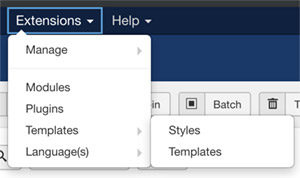Website Templates, or Themes, are web pages, or a series of pages, that provide all the main, common elements of a website design, ready for the user to input their own information consisting of text, structured with headings, images, and page titles for use in the navigation menu.
Modern website templates will use HTML5 along with CSS style sheets, and some may use Javascript, to provide the basic layout, the styling and formatting, and any special effects such as slideshows and page loading effects. Types of website template include:
- Static pages using HTML, CSS and JS
- Dynamically generated pages using PHP or ASP - usually as part of a content management system or CMS
- E-commerce templates that integrate with an e-commerce website solution
- Cloud based website providers, such as Wix, have their own website templates and CMS
CMS Templates
 Templates are available for all the major Content Management Systems (CMS) and cover a wide range of uses, such as art, business, e-commerce, food and photography. There should be a template for your CMS that is designed for your industry sector and could be almost ready to go! But often the templates do need some customisation to fit in with the company house style exactly, and to incorporate logos and other graphics that may need some adjustments.
Templates are available for all the major Content Management Systems (CMS) and cover a wide range of uses, such as art, business, e-commerce, food and photography. There should be a template for your CMS that is designed for your industry sector and could be almost ready to go! But often the templates do need some customisation to fit in with the company house style exactly, and to incorporate logos and other graphics that may need some adjustments.
The main CMS that have large numbers of templates available are WordPress, Joomla, Drupal, Umbraco and Moto CMS, and there are many others that are not as popular but have features that may make them useful for certain web publishing requirements.
Responsive Templates
A responsive design is one that ensures that the content is easily readable on any device, be that a large screen PC, tablet or mobile phone, with a large range of screen resolutions. The responsive layout will adapt to the screen size by resizing elements, changing the order in which they are displayed, or removing elements such as large images that can be removed without losing the meaning of the page.
Bootstrap Themes
Templates, or Themes, are available using the Bootstrap framework to create responsive website templates. Bootstrap uses HTML combined with CSS and JavaScript to provide the styling and layout of the website pages. Bootstrap use a grid system to lay out the page elements, and are relatively easy to use and customize. There are a lot of free Bootstrap templates available which we will list in the downloading website templates section.
HTML5 Templates
HTML5 is the latest version of HTML which combines HTML, CSS and JavaScript. The HTML provides the basic markup and structure for the website, with the CSS providing the style information, such as fonts, colours, heading styles, and the JavaScript to run any interactive features.